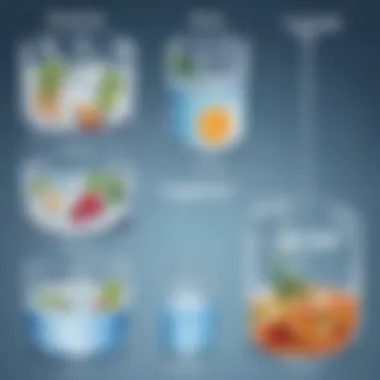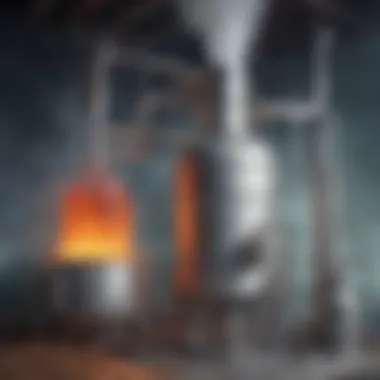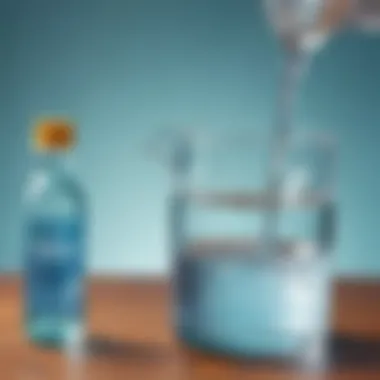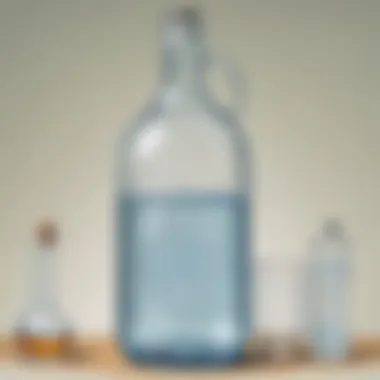Is Boiled Water Distilled? Explore Key Differences


Intro
Understanding the difference between boiled water and distilled water is essential for anyone interested in water purification and its effects on health. Though both types of water undergo heat treatment, the processes are fundamentally different in their goals and outcomes. Boiling water involves bringing it to a high temperature to kill microorganisms and make it safe for drinking. On the other hand, distillation is a more sophisticated method, involving evaporation and condensation to remove impurities and contaminants.
Through this article, we aim to dissect these two methods, clarify misconceptions, and explore their implications in daily life. By gaining a clearer understanding of boiled and distilled water, readers can make informed choices about what they consume.
Science Fun Facts
Interesting Trivia and Facts
- Did you know that boiling water can effectively kill bacteria, viruses, and parasites? The CDC recommends boiling water for at least one minute to ensure safety in places where water quality is questionable.
- Distilled water is considered to be more pure than standard bottled water. This is because the distillation process removes dissolved solids, as well as many organic compounds.
- In the early 1800s, distillation was used to purify alcohol. This technique eventually evolved into the modern process we use today for water.
Quirky Science Stories
There are countless stories in scientific history that illustrate the fascination with water purification. For instance, in the late 1800s, a scientist named Robert William Thomson invented the Thomson Steam Boiler as a means to distill water effectively on ships. This invention significantly improved water quality for sailors and is a precursor to modern desalination techniques.
Amazing Science Records
- The record for the largest distillation plant in the world is held by the Ras Al Khair plant in Saudi Arabia, which can produce up to 1.025 million cubic meters of water daily.
- The highest temperature for boiling water occurs at higher altitudes. For example, at 10,000 feet, water boils at about 193 degrees Fahrenheit instead of the usual 212 degrees at sea level.
Thought-Provoking Questions
- Why do we associate purification with boiling? Is there a deeper trust in traditional methods?
- What happens to minerals in water when it is distilled? Are they beneficial or necessary for human health?
Discover the Wonders of Science
Understanding the nuances of water purification can enhance our daily water consumption. Different scientific concepts provide insight into how we can improve our health through informed choices.
Exploring Various Scientific Concepts
From water cycles to chemical composition, each concept reveals something unique. For instance, understanding how heat affects water molecules can clarify why boiling or distilling impacts its properties.
Educational Videos and Animations
Several online resources provide visual aids that demonstrate these processes, making them easier to understand. Websites like Britannica offer videos that explain boiling and distillation in engaging ways.
Interactive Learning Tools
Interactive tools and educational games can turn learning into a fun experience. Many apps allow users to simulate the distillation process, highlighting how various factors affect purification.
Real-Life Applications of Science
The principles of boiling and distilling water extend beyond just making it safe to drink. They apply to cooking, scientific experiments, and even sustainability efforts in various industries.
Science Quiz Time
Understanding boiled and distilled water allows for deeper learning through quizzes. Testing knowledge can make the experience engaging.
Interactive Quizzes
Online platforms often provide quizzes to reinforce what is learned. For instance, questions that ask about the processes and outcomes of boiling and distilling help solidify knowledge.
Multiple Choice Questions
- What is the primary purpose of boiling water?
a) To remove dissolved minerals
b) To kill pathogens
c) To change its taste - What is a key advantage of distilled water?
a) It tastes better
b) It is free of impurities
c) It hydrates better
Brain Teasers and Puzzles
Incorporating puzzles related to water purification can strengthen critical thinking. Tasks might include arranging steps in the distillation process in correct order.
Learning Through Gamification
Gamifying the learning experience through assignments or challenges can engage students more effectively. Learning about water can occur through creative projects inspired by the topics discussed.
Science Experiment Showcase
Engaging young minds in practical science puts theory into practice. A simple boiling or distilling experiment can yield interesting results.
Fun and Engaging Experiments
One simple experiment involves boiling water and capturing the steam to see if it cools down into distilled water. Observing how condensation forms can bring the learning full circle.
Step-by-Step Instructions


- Boil a pot of water.
- Capture the steam using a lid.
- Place a cool bowl on top of the lid to collect water.
- Observe the distilled water collecting in the bowl.
Materials List
- Pot
- Water
- Lid
- Bowl
Safety Tips and Precautions
Always use caution when boiling water. Handle hot equipment with care to avoid burns or injuries.
Understanding boiled and distilled water not only helps in daily life choices but also opens up a realm of science-related curiosities. The exploration doesn't end here, as the world of water holds many more secrets.
Prologue to Water Purification
Water is essential for all forms of life. Ensuring its purity is crucial for human health. The process of water purification is not only about making water safe to drink but also about enhancing its quality for various purposes. In this article, we aim to explore the importance of water purity and the common methods used to achieve it. Understanding these methods provides insights into how we can better safeguard our health and the environment.
Importance of Water Purity
Water purity is vital for several reasons. First, drinking clean water prevents many health issues. Contaminated water can carry pathogens, chemicals, and heavy metals, leading to diseases. For small children and elderly people, the risks are even higher.
Second, pure water supports better taste and odour. Impurities often result in unpleasant scents and flavours. Purified water can significantly enhance the quality of beverages and food that we consume.
Lastly, clean water plays a role in environmental sustainability. By minimizing pollutants, we not only protect our health but also the ecosystems that depend on clean water sources.
Overview of Common Methods
There are several common methods used in water purification, each with its own advantages and limitations. The most recognized methods include:
- Boiling: This method involves heating water until it reaches its boiling point. While boiling kills many pathogens, it does not remove chemical contaminants or heavy metals.
- Distillation: This process involves evaporating water and then condensing the steam back into liquid. It effectively removes many impurities, including minerals and metals.
- Filtration: This method uses various filters to remove larger particles, sediments, and some chemical contaminants. Filters come in various forms, including those designed for home use and large-scale applications.
- Chemical purification: Chemicals can be used to disinfect water, such as chlorine or iodine. While effective, they may leave residual tastes or odours and do not remove all types of contaminants.
Each purification method has its specific use cases depending on the source of water and the intended use. With proper understanding, individuals and communities can choose the most suitable method for their needs.
Understanding Boiling Water
Boiling water is a common practice in many households. It is essential to appreciate this process because it serves as a foundational method to improve water quality. Understanding how boiling works can help clarify its role in water purification and distinguish its effects from other methods, particularly distillation. This section explores the boiling process, its significance, and the quality of water produced through boiling.
The Boiling Process Explained
Boiling water involves heating it to its boiling point, which is 100 degrees Celsius under standard atmospheric pressure. This process causes water to change from a liquid state to vapor. The heat energy supplied to the water causes molecules to move energetically, leading to the formation of bubbles and eventually the transition to steam.
When we boil water, several physical changes occur. Contaminants within the water, such as bacteria or viruses, generally cannot survive the high temperature. This makes boiling an effective method for disinfecting water. Many people boil water when they suspect it is contaminated or when they are preparing food. However, it is crucial to understand that while boiling can eliminate some pathogens, it does not remove all impurities, such as heavy metals or certain chemicals, that might be present. This distinction is important when considering the overall safety of drinking boiled water.
Effects of Boiling on Water Quality
The effects of boiling on water quality can be both positive and negative. On the positive side, boiling is effective at killing potentially harmful microorganisms. It can significantly reduce the risk of waterborne diseases. However, boiling does not improve the taste or odor of water and can even concentrate impurities left after evaporation. This creates a paradox where water might be free from pathogens but still contains other undesirable elements.
Additionally, the water may lose some dissolved oxygen and certain volatile compounds during boiling. As a result, the flavor profile could change. Users may notice that boiled water tastes flatter than its unboiled counterpart.
In summary, understanding boiling water's process and effects is crucial for determining when and how to use it effectively for water purification. It empowers users to make informed choices about their drinking water, ensuring both safety and quality.
Key takeaway: Boiling effectively kills harmful microbes, but it does not eliminate all impurities, making it an important yet limited method of water purification.
The Science of Distillation
Understanding distillation is vital for recognizing how water purification works on a deeper level. This method is not just about removing impurities; it also transforms water in significant ways that affect its usability and safety. Distillation separates components based on boiling points, making it essential for various applications, from laboratory use to everyday water consumption. The process allows for the creation of purified water, which can be especially valuable in settings where water quality is crucial.
How Distillation Works
Distillation begins by heating water until it vaporizes. During this phase change, impurities are left behind as they do not evaporate with the water. As water vapor rises, it passes through a cooling system called a condenser. This system cools the vapor back into liquid form, collecting the purified water in a separate container. The boiling point of water is approximately 100 degrees Celsius, but many impurities, such as salts and heavy metals, have much higher boiling points. Therefore, they remain in the original container, allowing distilled water to be free of most contaminants.
The process can be summarized in a few steps:
- Heating water to its boiling point.
- Converting water to vapor, leaving impurities behind.
- Condensing vapor back into liquid.
- Collecting the distilled water in a clean container.
Applications of Distilled Water
Distilled water has several applications across various fields. Here are some notable uses:
- Laboratory Settings: Distilled water is often required for experiments. It ensures that no additional variables, such as minerals or contaminants, interfere with results.
- Medical Uses: In hospitals, distilled water is used for preparing medications and cleaning equipment, as it minimizes the risk of infections from impurities.
- Household Use: Many people choose distilled water for their appliances like steam irons and humidifiers. It helps prevent mineral buildup, extending appliance life.
- Beverage Production: Some beverages, especially those that require precise flavoring, benefit from using distilled water to maintain consistency in taste.
Distillation is a reliable method to ensure water purity, making it suitable for both laboratory and everyday needs.
By exploring the science of distillation, we see that it offers a comprehensive approach to water purification. This process is not just a means of obtaining clean water; it also plays a fundamental role in various applications that affect health and safety.


Comparing Boiling and Distillation
Understanding the distinctions between boiling and distillation can greatly enhance our knowledge of water purification. In both methods, water undergoes a physical change, yet the end results and efficiency differ significantly. This section will compare the two techniques by examining their processes, outcomes, and implications.
Key Differences in Processes
The fundamental difference between boiling and distillation lies in how each method purifies water.
Boiling is a simple method involving heating water to 100 degrees Celsius until it transforms into steam. This process effectively kills most pathogens, such as bacteria and viruses. However, boiling does not remove all contaminants; dissolved salts, heavy metals, and some chemicals remain in the water. Hence, while boiling improves safety, it does not guarantee purity.
In contrast, distillation involves not just boiling but also the condensation of steam back into liquid water. When water is boiled, its vapor rises and leaves impurities behind. Then, this vapor is directed into a cooling mechanism where it condenses back into liquid form. As a result, distillation removes a broader range of impurities, including those that boiling cannot.
Outcomes of Each Method
The outcomes from boiling and distillation reflect their operational differences and efficiency.
- Effectiveness Against Pathogens:
Boiling is generally effective at eliminating bacteria and viruses, making it suitable for emergency situations or when safe drinking water is scarce. Yet, it might fall short in the presence of chemical contaminants.
Distillation, on the other hand, provides a more comprehensive solution. It can remove not just microbes but also minerals and chemicals, leading to purer water. - Chemical Composition:
Boiled water may retain certain dissolved solids, which can influence taste and health. For the most part, these remain undetected.
Conversely, distilled water is chemically transformed and lacks dissolved solids altogether. This can be ideal for specific applications where contaminant-free water is needed, such as in laboratories or for certain medical uses. - Practical Applications:
Boiled water serves well for cooking and making tea or coffee, where some minerals can enhance flavor.
Distilled water can be key in industrial processes and equipment that require mineral-free water to avoid scaling or corrosion.
"Both boiling and distillation serve important roles in water purification, each suitable for different contexts and needs."
In summary, the key differences between boiling and distillation affect the safety, taste, and cleanliness of water. Awareness of these differences assists in making informed choices regarding water purification methods.
Common Misconceptions
In understanding the nuances of water purification, particularly regarding boiled and distilled water, several misconceptions have arisen over time. These misunderstandings can lead to confusion about what these processes actually achieve and their effectiveness. Addressing these misconceptions is key to ensuring that people not only use water effectively but also comprehend the implications of their choices for health and safety.
Boiled Water as Distilled Water
Many people often think that boiled water is synonymous with distilled water. While both processes lead to heated water, the effects on purity are quite distinct. Boiling water involves heating it to its boiling point, which eliminates some microorganisms and pathogens. However, boiling does not remove dissolved solids, minerals, or other impurities. In contrast, distilled water undergoes a process where water vapor is collected after boiling, leaving most contaminants behind.
This means that while boiling may make water safer for consumption by reducing harmful microbes, it does not purify the water in the same way that distillation does. The point to remember is simple: boiled water may be cleaner but is far from being distilled.
Misunderstanding Purification
Another critical aspect of the common misconceptions relates to the broader understanding of purification methods. Many individuals may assume that boiling water renders it completely safe, neglecting the fact that certain chemicals, like chlorine, do not evaporate during the boiling process. Thus, boiled water may still contain harmful substances.
On the other hand, distillation can be seen as a more thorough purification method because it effectively removes most contaminants, including bacteria, viruses, heavy metals, and salts. It is important for consumers to recognize these distinctions to make informed decisions about their water choices.
"The method of purification affects the quality of water significantly; understanding this is vital for better health choices."
In essence, the misconceptions surrounding boiled water and distilled water stem from a lack of awareness about the actual purification processes involved. Familiarity with these concepts will help individuals choose the proper method for their specific needs.
Health Considerations
Understanding health considerations related to boiled and distilled water is crucial for making informed choices about our water consumption. The different methods of purifying water can have significant implications for health, especially concerning microbial contaminants and mineral content. Each method influences the quality of the water we drink and use for cooking.
Effects on Microbial Contaminants
Boiling water is widely recognized as an effective way to kill a variety of pathogens, including bacteria and viruses. The high temperatures achieved during the boiling process can significantly reduce the presence of harmful organisms in water. This is particularly important in areas with limited access to safe drinking water. Researchers often emphasize that boiling water for at least one minute can effectively eliminate most microbial contaminants.
However, boiling does not remove all impurities. Chemical pollutants and heavy metals may still be present after boiling. Therefore, it is vital to assess the water source to understand any residual contaminants. For instance, if the water contains lead or nitrates, boiling will not address these issues.
In contrast, distilled water undergoes a process that not only removes microbes through evaporation but also keeps many of them from entering the final product. This makes distilled water a safer choice in some situations, but it also lacks some beneficial minerals found in natural water sources.
"Boiling kills most microbes but doesn't remove chemicals or minerals. Distillation removes both, providing a pure water but missing out on some natural benefits."
Mineral Content in Water
The mineral content of water profoundly affects both taste and health. Natural water sources often contain essential minerals like calcium and magnesium. These minerals play a role in bone health, heart function, and other bodily processes. Boiled water retains these minerals, making it a reasonable option for hydration.
Distilled water, on the other hand, has had all its minerals removed. This can have implications for individuals relying exclusively on distilled water as their primary hydration source. Over time, a lack of essential minerals from water might lead to deficiencies, especially if dietary sources are not sufficient.
A balanced approach can benefit various people. For daily hydration, using boiled water can support mineral intake, while distilled water might be a suitable choice for specific health concerns where purity is a priority. Understanding mineral content leads to healthier choices and educated discussions regarding water consumption.
In summary, the health considerations regarding boiled and distilled water highlight the importance of not only purification methods but their implications on health and nutrition. Being aware of microbial risks and the role of minerals in water is essential for making informed choices.
Practical Uses in Everyday Life
In the context of water purification, understanding the practical uses of boiled and distilled water is crucial for making informed decisions. Both methods serve specific purposes in daily activities. Choosing the right type of water can have significant implications on health, taste preferences, and even certain culinary outcomes. Here, we explore how boiling and distillation influence two important areas in everyday life: cooking and drinking, and laboratory applications.
Cooking and Drinking
Boiled water is commonly used in kitchens around the world. Boiling water kills many harmful microorganisms, making it safe for cooking and drinking. For instance, when preparing pasta or rice, boiling water provides a healthy cooking environment. It helps to soften food and ensures that the final dish is free from pathogens like bacteria that might be present.


Distilled water, on the other hand, is often chosen for its purity. It's free from contaminants and minerals, which some people prefer when making beverages or using for cooking. This type of water can also be better for some recipes in which mineral content may alter the flavor or texture of the dish, like pastries and syrups.
When consuming beverages, some individuals choose distilled water for its clean taste. However, boiled water is more practical for daily hydration. It is important to understand the different benefits and limitations of each. For example:
- Boiled Water: Safe to drink, effective for cooking, affordable.
- Distilled Water: Highly pure, better for certain recipes, often used in beverages like coffee and tea.
"Choosing the right water for cooking reacts significantly on the final meal’s quality. Understanding the differences is important for advanced cuisine."
Laboratory Applications
In scientific contexts, the choice between boiled and distilled water becomes even clearer. Laboratories often require distilled water because it minimizes the risk of chemical reactions caused by impurities. This is essential in experiments and procedures where precise measurements or clean conditions influence outcomes.
Boiled water may not be suitable for sensitive laboratory applications. For instance, when conducting qualitative analyzes or chemical testing, even trace amounts of minerals could interfere with results. Thus, distilled water is the preferred choice for:
- Reactions requiring precision: Complete free from contaminants, which could alter the reactions.
- Equipment cleaning: Instruments are washed with distilled water to avoid mineral residue.
- Biological experiments: Ensures that pathogens are not present during delicate processes.
In summary, recognizing the specific applications of boiled and distilled water empowers individuals to make better choices, whether in the kitchen or in scientific laboratories. These practices not only underline the utility of each method but also stress the importance of water purity in everyday usage.
Environmental Impact
Understanding the environmental impact of water purification methods, particularly boiling and distillation, holds significant importance. As global concerns about water scarcity and pollution increase, examining how these processes affect our natural resources and energy usage becomes essential. This section will explore two critical aspects: the sustainability of water resources and energy consumption in distillation.
Sustainability of Water Resources
Sustainability involves the careful managing of our natural resources to ensure their availability for future generations. When we evaluate boiling and distillation, both processes have various implications. Boiling water is a relatively simple process that requires no special equipment. It primarily uses heat, usually from an electric or gas stove, which means its environmental footprint may be lower than complex methods.
However, the sustainability of water resources is a broader issue. The key in using boiled water lies in the conservation of water itself. Boiling encourages minimal wastage, as it is often done for immediate consumption. On the other hand, distillation generally consumes more water, as it often requires a larger volume of liquid to produce a smaller amount of distilled water. Therefore, while both methods are valuable, boiling may present a more sustainable choice in some situations.
Energy Consumption in Distillation
Energy consumption is a crucial factor in assessing the environmental impact of any water purification method. Distillation is energy-intensive compared to boiling. It requires a heat source to evaporate water and then condense it back into liquid form. With rising energy costs and a focus on reducing carbon footprints, this makes distillation less appealing under certain circumstances.
Boiling, while also requiring energy, often uses less overall, especially in smaller quantities, as it doesn’t need complex equipment.
"Choosing the right method not only affects water quality but also has serious implications for energy resources."
To sum up, understanding the environmental implications of every method we rely on is essential. In order to make informed decisions that benefit both ourselves and our planet, we need to weigh the sustainability of water resources against the energy consumption involved in various purification methods. Both boiling and distillation offer unique advantages, but their environmental impacts can vary significantly based on how we choose to use them.
Alternatives to Boiling and Distillation
In the pursuit of clean and safe drinking water, many methods exist that can serve as effective alternatives to boiling and distillation. This section will examine these options, emphasizing their specific elements, benefits, and considerations.
Filtration Systems
Filtration systems have become more widespread for treating water. They work by physically removing impurities, including sediments, chemicals, and microorganisms. There are different types of filters, such as activated carbon filters, reverse osmosis systems, and ceramic filters.
- Activated Carbon Filters: These are common in household water filters. They can absorb chlorine and various other contaminants, improving taste and odor. However, they do not remove all pathogens, so they work best with other methods.
- Reverse Osmosis Systems: This systems filter water by forcing it through a semi-permeable membrane. It removes many dissolved solids and chemicals. This method is very effective but can be slow and wastes some water in the process.
- Ceramic Filters: These are made of porous ceramic materials that can filter out bacteria and sediment. They are often used in portable water filtering devices.
Filtration systems often provide a more practical solution for day-to-day water purification. They offer convenience, especially in urban settings where water quality is inconsistent. However, maintenance is essential to ensure optimal performance.
Chemical Purification Methods
Chemical purification methods are also significant in water treatment. This approach usually involves adding substances to water to eliminate harmful microorganisms and contaminants. Common methods include chlorination, iodine treatment, and UV treatment.
- Chlorination: This method uses chlorine to kill bacteria and viruses in water. It is widely used because it effectively disinfects large quantities of water. However, it can leave a taste and odor.
- Iodine Treatment: This involves adding iodine to water. It is suitable for small quantities and is often used in emergency situations or by campers. While effective against pathogens, it is not always recommended for long-term use due to potential health risks.
- UV Treatment: Ultraviolet light can disinfect water by damaging the DNA of microorganisms. This method is chemical-free and leaves no residual taste, making it increasingly popular.
Choosing the right alternative depends on several factors, including the specific contaminants present in the water, the quantity needed, and personal preferences related to taste and convenience.
"Understanding these methods helps make informed choices about water safety and health."
In summary, alternatives to boiling and distillation offer various solutions for purifying water. While each method has its strengths and drawbacks, together they provide a broad toolkit for ensuring safe drinking water.
Ending
In the quest to understand the similarities and differences between boiled water and distilled water, it becomes clear that both processes play unique roles in water purification. This article serves to highlight the importance of these methods not just in terms of health, but also in practical applications.
Summarizing Key Points
In summary, it’s important to recognize the key distinctions:
- Boiling Water: This method primarily kills bacteria and pathogens, making it suitable for emergency situations or when safe drinking water is not available. However, boiling does not remove dissolved solids or chemicals.
- Distilled Water: This process involves boiling water and then condensing the steam back into liquid form. It effectively removes impurities, including minerals, making it pure for specific applications like laboratory use or certain medical scenarios.
Thus, while both methods have purification benefits, they serve different purposes and are suitable in different contexts.
Encouraging Informed Choices
Making informed choices about water purification can significantly impact health and safety. Parents and caregivers should:
- Evaluate the source of their water supply and potential contaminants.
- Understand when to use boiling versus distillation based on specific needs.
- Consider water filtration systems or other purification methods, like chemical treatments, when applicable.
By educating themselves on these processes, individuals can better protect the health of their families and ensure access to safe drinking water. The differences between boiled and distilled water should guide choices about water consumption and usage.







